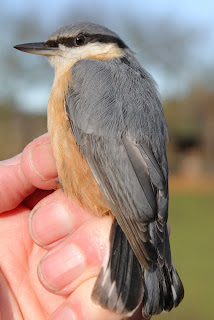It was a much brighter start to today; with dare I say even atypical bright morning sunshine that lessened the impact of a touch of frost and the cold northerly wind.
Along the Pilling lanes towards Lane Ends there were plenty of Lapwings again, some now sporting impressive wispy crests in preparation for the breeding season, and although I couldn’t be sure, I thought I saw a distant couple tumbling around in a brief practice. But against a blue sky background the black and white of Lapwings in everyday flight is exciting enough without the added thrill of watching them display. I counted 160 Lapwings close to Fluke Hall, along with 80 Redshank whilst hundreds of Pinkfeet flew across to land within earshot but out of sight behind the inner sea wall and almost in some lucky person’s backyard in Pilling village.
 Lapwing
Lapwing Lapwing
Lapwing Pink-footed Goose
Pink-footed GooseI stopped at Lane Ends where I was early enough to see five Little Egrets flying off, scattering east and west along the marsh to their desired feeding spots. I walked to the east pool where just as I spotted it from the corner of my eye, the Kingfisher saw me and flew down from the bushes at the edge of the water and now low over the water, headed quickly along the ditch towards Cockerham. Kingfishers are such a frustrating beast, so inconspicuous for such a tiny bird, always first to see you and for ever keen to fly off where they can’t be seen. There was the normal Mallard throng on the pool waiting for handouts but the Goldeneye pair were well worth a second look, even though the male made sure they kept a more sensible distance from me than the Hovis hungry Mallard. A partial walk towards Pilling Water revealed several Snipe amongst last night’s tidal debris that like the earlier Kingfisher, saw me early then flew off without stopping to suss me out. I also counted 15 Skylark along here before reaching Pilling Water now partially frozen again but hosting a single Black-headed Gull, and out in the near distance 8 Whooper Swans and several hundred more pinkies.
 Goldeneye
GoldeneyeDriving up towards Cockerham and just past Sand Villa I could see ahead a Magpie harassing a slow flying roadside Barn Owl, but as I approached nearer the owl flipped over the hedge and out of sight where I couldn’t see it, especially as I had the usual moronic bumper hugger for company. I stopped at Braides hoping to see more of the owl but it must have gone in another direction so I counted the Lapwing, 300+ and the Golden Plover, 75.
Having done the circuit earlier in the week I wasn’t keen to do the Cockersands, Jeremy Lane, Glasson route again, particularly at the thought of bumping into weekend pagerites on the rampage for the American Wigeon, so I opted to spend an hour or two at Conder Green and watch the tide roll slowly in. Not very exciting I know, no ticks, no banter, no ringing in the ears, no tripping over half abandoned tripods, and how would I find out about the next bird on today’s must-see-list?
But I had a great time, sitting in the sun, taking a few pictures, watching some beautiful common birds just going about their business as the human world speeds by, mostly oblivious to the joys of the natural world: Shelduck 11, Tufted Duck 5, Little Grebe 2, Meadow Pipit 2, Reed Bunting 2, Snipe 8, Teal 90, Goldeneye 2, Spotted Redshank 2. Greenshank 1, Grey Plover 2, Grey Heron 1, Wigeon 4, Lapwing 32, Redshank 14, Cormorant 4
Now there’s a proper list and I found them all myself.
 Teal
Teal  Shelduck
Shelduck  Greenshank
Greenshank 



































































.jpg)












